A Current Issue: Analysis of Semantic Perspective Shifting for Meaning in Indonesia Linguistic Context
DOI:
https://doi.org/10.31597/sl.v2i2.517Keywords:
Semantics, analysis, shifting meaning, Indonesian, linguistic contextAbstract
Semantic word is actually a technical term that refers to the study of meaning. Semantics in Indonesian derived from the Greek 'sema' (noun) which means 'sign' or 'symbol'. The verb is 'semaino' which means 'mark' or 'symbolize'. The present study aims to examine the factors that can affect the shift of meaning in Indonesian based on current linguistic context. This study used qualitative research where the intent is to provide a detailed, in-depth description of everyday life. Data was taken from Indonesian language that may address particular themes that may facilitate the use of specific linguistic features. It tends to capture the reality of social life taking place in Indonesia. The result of this study shows that the type of meaning can be distinguished based on some criteria and points of view. The findings indicate that the type of meaning can be distinguished based on semantic types, namely between lexical meaning and grammatical meaning; based on the presence or absence of referents in a word, to distinguish the referential meanings and non-referential; based on the presence or absence of a sense of value in a word, to distinguish the connotative meaning and denotative; based on accuracy of its meaning, to distinguish the meaning of the term or the common meaning and special significance; kind of meaning can also be classified into two types, namely lexical meaning and contextual meaning
References
Chaer, Abdul. 2007. Linguistik Umum. Jakarta : Rineka Cipta.
Heimt, Irene. 1982. Semantics of Definite and Indefinite Noun Phrases. Ph.D dissertation, University of Massachusetts.
Heimt, Irene and Angela Kratzer. 1998. Semantics in Generative Grammar. Blackwell.
Horn, Larry. 1972. On the semantic properties of logical operators in English. Bloomington: Mimeo Indianan University Linguistics Club.
http://lusiisya.blogspot.com/2011/02/tugas-akhir-mk-linguistik-umum-semantik.html.
accessed 03 July 2013
http://sastrawancyber.blogspot.com/2010/04/pengertian-semantik-menurut-beberapa.html. accessed 03 July 2013
Jack. 1972. Semantic Interpretation in Generative Grammar. Cambridge: MIT Press.
Leech, Geoffrey. 2003. Semantik. Yogyakarta: Pustaka Pelajar.
Lyons, John. 1977. Semantics. 2 vols. Cambridge: Cambridge University Press.
Lyons, John. 1995. Linguistic Semantics: An Introduction. Cambridge: Cambridge University Press.
Parera. 2004. Teori Semantik. Jakarta: Erlangga.
Ullmann, Stephen. 2007. Pengantar Semantik. Yogjakarta: Pustaka Pelajar.
Valin, Robert D. Van, and Randy J. LaPolla. 1997. Syntax. Structure, meaning and function. Cambridge: Cambridge University Press.
Verhaar, J.W.M. 2004. Asas-Asas Linguistik Umum. Yogjakarta: Gadjah Mada University Press.
Verspoor, Cornelia Maria. 1997. Contextually-Dependent Lexical Semantics. PhD dissertation, University of Edinburgh.
Downloads
Published
How to Cite
Issue
Section
License
1. Copyright of this journal is possession of Editorial Board and Journal Manager, by the knowledge of author, whilst the moral right of the publication belongs to the author.
2. Legal formal aspect of journal publication accessibility refers to Creative Commons Atribution-ShareAlike (CC BY-SA), implies that this license lets others remix, adapt, and build upon your work even for commercial purposes, as long as they credit you and license their new creations under the identical terms. This license is often compared to “copyleft” free and open source software licenses.
3. Every publications (printed/electronic) are open access for educational purposes, research, and library. Other that the aims mentioned above, editorial board is not responsible for copyright violation















